Satellite Internet — Past & Present
Saturday, March 4. 2023
About satellites
ESA has a really good information package Space Transportation - Types of orbits.
When context is satellite Internet, there are pretty much three options: LEO, MEO or GEO. As satellites fly high, latency from Earth's surface to satellite and back is a factor. Low Earth Orbit is the most common choice, altough the lower you fly, the more satellites are required for reasonable coverage.
Past
Inspiration for this blog post came from my 1998 LUT course presentation of Satellite Internet. 25 years ago IT-bubble was still growing and it was about two years before it bursted. As I was a telecommunications major, I took a seminar course which contained a presentation. From the list of topics available, apparently I chose satellite Internet. Back in those days getting the bandwidth delivered to everybody was in rapid growth. Mobile Internet was mostly non-existent, fiber-to-the-home was non-existent, dial-up model, ADSL or cable-TV internet were the methods for getting to The Net.
Here is my PDF presentation about satellite networks Iridium, Globalstar and Teledesic (in Finnish):
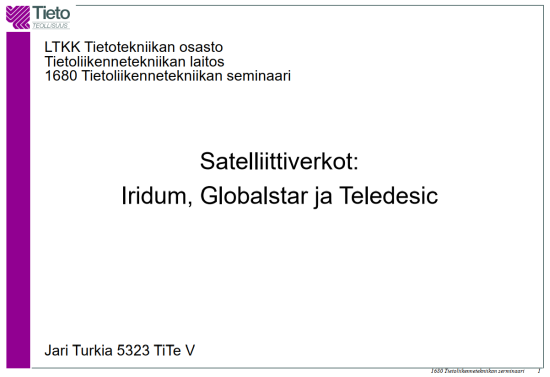
This past can be considered as Round #1 of satellite internet.
Retrospective: Iridium
Went into production. 2nd generation begun deploying in 2017. Not generally known, nor common. Originally, not financially viable.
Retrospective: Globalstar
https://www.globalstar.com/, LEO
Went into production. 2013 2nd generation, 2018 3rd generation announcement. Apple iPhone 14 emergency messages are using 2nd gen Globalstar. Not generally known, nor common. Originally, not financially viable.
Retrospective: Teledesic
Never saw production. Project suspended 2002 as IT-bubble bursted and saw financial problems of Iridium and Globalstar. Completely vaporware and nobody knows this ever existed. Plan was to have hundreds of LEO satellites for really fast Internet connectivity.
I have to mention their tech. Instead of traditional approach all others have, relying on ground station being able to find a passing satellite, Teledesic originally planned having 840 satellites. As it was extremely expensive, they later reduced the number to 288. Their idea was to map Earth into regions and having enough capacity, multiple satellites were available at one "square" at a time to provide massive speeds. In theory, really good idea!
Other services
My presentation contained only three companies/services as the topic given to me dictates. At the time, other satellite services did exist.
Still today, Inmarsat Broadband is well known for its voice capabilities and mobile units made famous in popular culture. They do support broadband connection in their GEO satellites. This Satphone 2 is a well-known product:
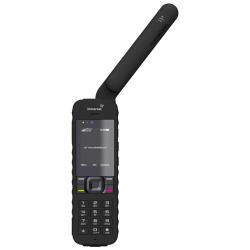
Another not well-known service is ORBCOMM, an IoT service provider. As their service is targeted to hardware manufacturers, not consumers, nobody has not ever heard of this one. Their 50+ satellites are LEO.
Present
Fast-forward to today.
Obviously Iridium, Globalstar, Inmarsat and ORBCOMM do still exist. As there are some changes in service offering for the past 25 years, let's do a recap of the new players.
SpaceX Starlink
https://www.starlink.com/, very low LEO
Mr. Musk and his Starlink is getting tons of media attention, especially for his donation of terminals to Ukraine to help them in war against Russia. This well-known service is farthest from vaporware, is affordable and easily available. Broadband speed is reasonable, see Ookla Speedtest results comparison.
Notable fact about Starlink is, they are the only satellite broadband provider so far to have their own vehicle for orbiting their own satellites. This capability will give them much required longevity. Satellite Internet is not a sprint, after all.
HughesNet / EchoStar
https://www.hughesnet.com/, GEO
Originally Hughes Communications was owned by Hughes Aircraft, the company founded by Howard Hughes. They are a major service provider in Americas. Here in Europe, they're not well known.
Viasat
https://www.viasat.com/space-innovation/satellite-fleet/viasat-3/, GEO
This is an upcoming broadband service. Viasat is a known satellite-TV operator expanding its services to Internet.
Amazon / Project Kuiper
Obviously Mr. Bezos want's to compete against his nemesis, Mr. Musk and launch his own satellite Internet. His project is the most recent one and really doesn't even have a proper website.
Boeing
LEO
The legendary aircraft manufacturer wants their share of satellite Internet business. This very recent project has FCC approval for 147 satellites, but not much is known about the project.
Future?
As we learned back in 2002 when Teledesic folded, there isn't room for all above players. Some of them will fold and/or merge. Especially SpaceX is gaining lot of customers in rural areas with their modern service offering. Having a fierce battle-of-pricing won't be happening. Launching those satellites is v e r y expensive. Lacking financial stability, not everybody will survive in this Round #2.
There is plenty of space in the sky. It is already crowded and traffic jam is likely to get worse as more and more satellites are launched. Just take a look at Wikipedia's Satellites orbiting Earth -article.
Nokia 5.3 de-bricking after reset
Friday, March 3. 2023
Given the vast differences between Apple's iOS and Google's Android platforms, I own, run and operate both. For those interested: Apple I have as my daily mobile, Android, the more popular platform, I use for more experimental features which are not available on the other one. These features include: access to mobile radios, access to NFC and Bluetooth.
Nokia (or HMD Global to be precise) is a really good Android mobile manufacturer. Generally speasking, they don't bloat their firmware with mandatory always forced-on Facebook or any such crap. Also, my years old 5.3 got Android 12 update. Obviously, this was nice as most manufacturers sell you forgetware getting no updates, but ... (there is always a but-part). What typically happens with electronics, is the hardware becomes obsolete faster than consumer would like to. This puppy doesn't pack the oomph in it's Snapdragon CPU to fluently run Android 12. I had no problems with Androids 10 or 11, with 12 everything started feeling too sluggish. To shopping I went. I came back with a Nokia G21.
Resetting an Android
Onboarding new phone was almost painless. Most icons on my start screen were lost, apps were loaded from Play, icons not so much. Such a thing is easy to fix, so I made the call to do a full reset to the old mobile. That is the standard procedure when you're about to donate/sell/hand out your old computing hardware.
Aftermath – Reset bricked my Nokia!
Crap! The thing failed to boot after reset.
What! What? How is this possible?
Yes, I wasn't alone. Nokia Community forum has following post: WARNING - Do NOT factory reset Nokia 5.3 -- Bricked phone. Factory resetting stuff is such a basic operation done commonly, I didn't much do any research for it. On hindsight (it is 20-20 always) I should have done some.
De-brick
On above thread Mr. Adam Howard faced the same situation and presented a solution.
Prerequisites
Following is needed:
- A computer capable of running Android SDK.
- I used macOS, no drivers or such needed
- I know Linux will work fine, my understanding is no drivers are needed there either
- Windows is known to work, but will require device driver for Android. Which one? No idea here.
- Enough permissions and skills to run Android tools on your computer.
- USB-C cable to connect Android to your computer
- Make sure the device is unconnected, it will be connected later
- Android SDK Platform Tools
- Available @ https://developer.android.com/studio/releases/platform-tools
- Install and test run Android Remote Debugger
adb
- Nokia 5.3 Android 12 firmware
- Available @ https://android.googleapis.com/packages/ota-api/package/d50cb0137919fd20d43cb67a7cb47a073966269d.zip
- Do NOT unzip! Package is needed by
adbin zipped form.
- That's it! Time and your favorite beverages (don't spill, electronics and liquids won't match).
Hard reset / Recovery mode
Apparently you can manually reset any Nokia 5.3 enough to force it into a mode suitable for force installing a new firmware. In this situation, obviously very helpful for recovery purposes. Scary as hell if you have a habit of losing your mobile to dishonest people. They can do nasty stuff to your mobile.
Instructions are here: HardReset.info: How to put NOKIA 5.3 in recovery mode?
Here is the sequence:
- Power off device
- Power on. This is your typical turn-it-on -sequence. Press power-button for ~4 seconds.
- This is your typical turn-it-on -sequence. Release power button.
- Press and hold: power button & volume down.
- Keep pressing the buttons until recovery screen appears: "START"
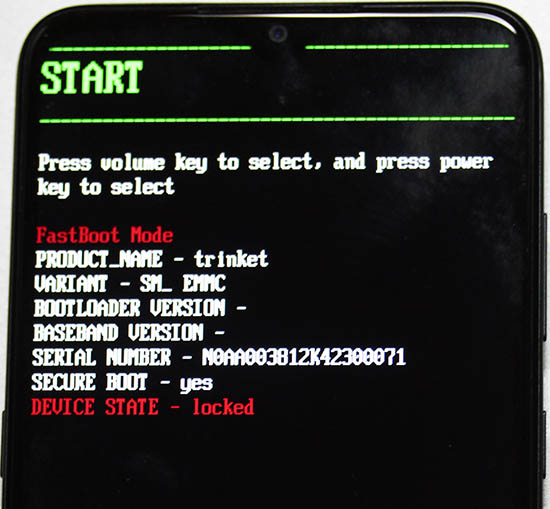
- Tap volume down 2 times: "Recovery mode"
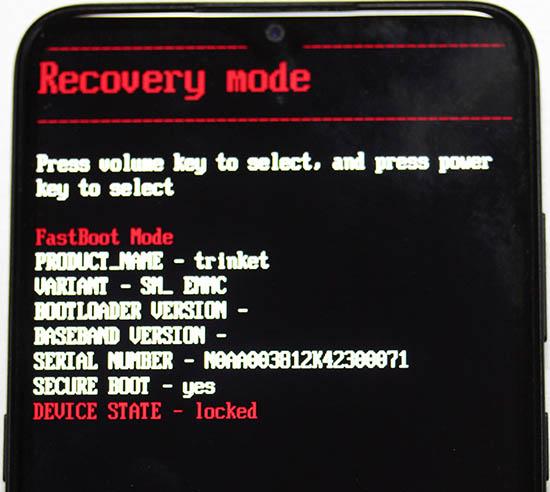
- Press power button to select Recovery mode
- Device will restart.
- Wait for Android with side open to appear. Note: there are no options in this screen.
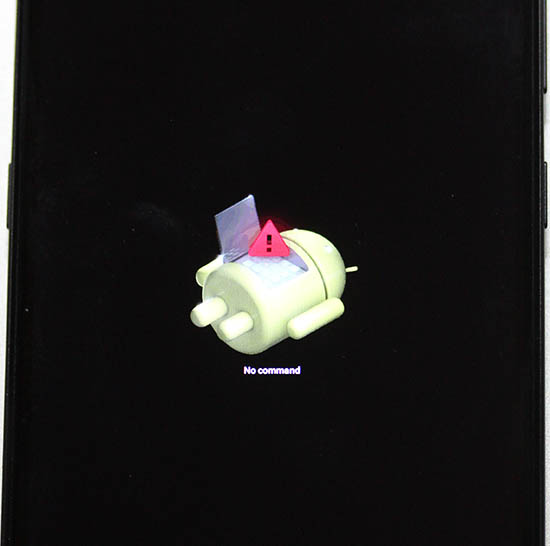
- Press and release: power button & volume up.
- Android Recovery menu will appear
- Tap volume down 3 times, "Apply update from ADB"
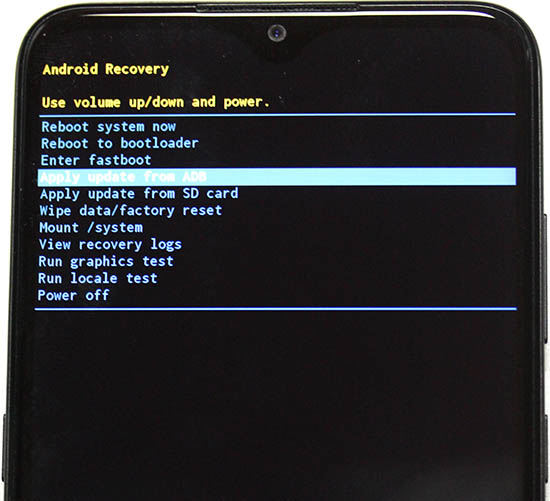
- Connect cable
- Press power button to select Apply update from ADB
- Leave you mobile be, next operation will be done on your computer.
On your computer: Upload firmware
Here is the sequence:
- Requirement: Your mobile must be waiting for firmware to be uploaded
- Info: Android Platform Tools (directory
platform-tools) will contain utilityadb - Info: You will be using sideload-function of
adb. Info @ Sideload ROMs and Mods Using ADB Sideload - Run adb and point it to downloaded firmware, adapt your filename:
adb sideload ../Nokia\ 5.3\ firmware.zip - On your mobile following will happen:
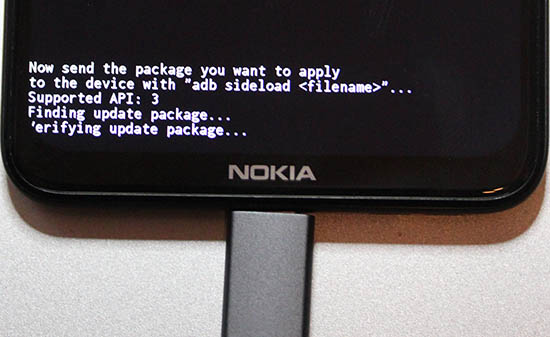
- As time passes, progress will be updated:
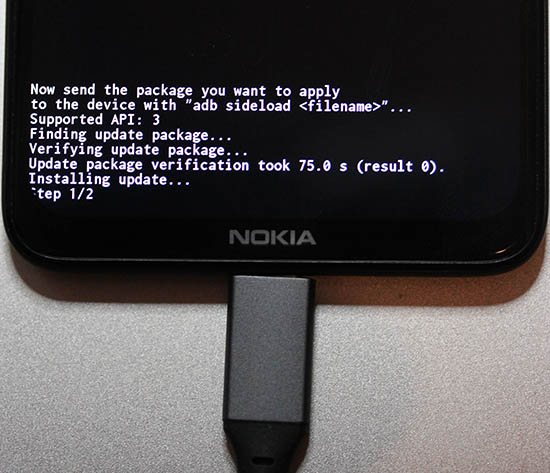
- Firmware update done
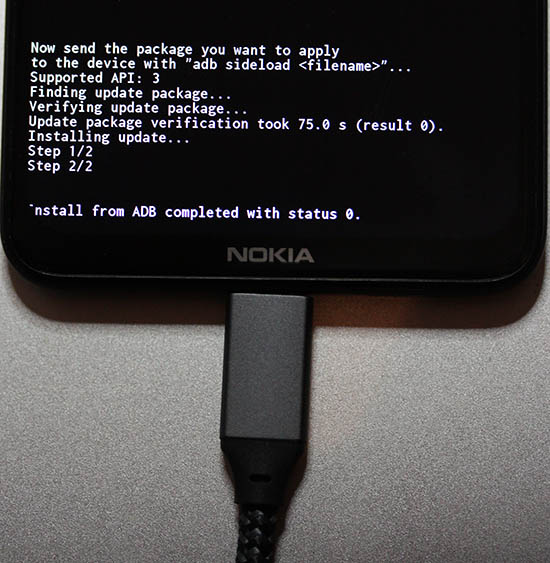
- That's it!
Done
Observe out-of-box -experience on your mobile:
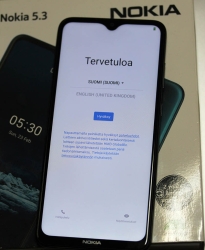
This is a major blooper by HMD guys. The community forum is full of angry people who bricked their 5.3 with Android 12.

